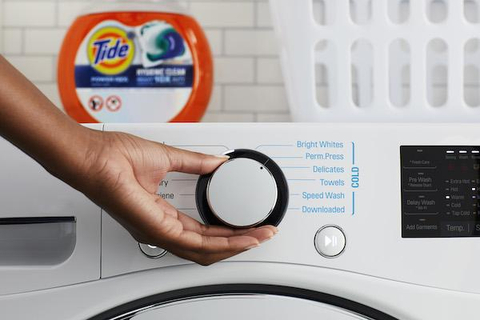New Research from Tide and WWF Helps Unlock the Secrets to Sustainable Behavior Change
Using Washing Laundry on Cold as a Model, Tide and WWF Explore How to Advance Eco-Habits with Consumers

Washing on cold saves up to
Tide and WWF engaged behavioral science consultancy, Behavioral Insights Team (BIT), to undertake a comprehensive review of existing published research and case studies on sustainable habits, including relevant consumer tests from P&G and best practices in climate change impact from WWF.
As brands and organizations increasingly seek to unlock habit change to enable widescale positive environmental benefits, the findings from the Tide and WWF project identified the importance of applying behavioral frameworks and systems thinking, such as:
- Enabling new consumer habits by creating the capability to act either physically or psychologically, the opportunity to act via cues or feelings of social acceptance, and the motivation to act through alignment with intrinsic values or delivery of extrinsic rewards; and
- Introducing interventions that are ideally a combination of easy (requires minimal effort), attractive (offers worthwhile incentives), social (makes one feel part of a group) and timely (uses relevant moments and offers a clear timeline for benefits).
“For brands like Tide and many others, consumer use often makes up a significant portion of a product’s carbon footprint,” said
“When Tide set a goal for 3 out of 4 washes to be done on cold by 2030, we knew we’d need partners to help us drive the change,” said
Through the program, Tide developed an “ecosystem” to advance the habit of washing laundry on cold. The map focuses on increasing enablers and reducing barriers, such as encouraging cold as the default setting on washing machines, introducing disruptions at the point of laundry and helping make cold water washing a social norm through continued brand marketing and communications campaigns.
Washing in cold saves up to
As one of America’s most trusted laundry detergents, Tide has helped lead the charge to switch to cold water washing for more than 20 years with breakthrough innovations like enzymes specifically optimized for performance in lower wash temperatures. Efforts to drive cold water adoption were advanced by the announcement of Tide’s 2030 Ambition, a set of broad-reaching sustainability commitments as part of Tide’s ongoing journey to decarbonize laundry, including a goal to cut GHG emissions by half in Tide’s manufacturing plants by 2030.
For more information on cold water washing and Tide’s collaborative journey to make cold wash the next broadly adopted eco-habit, please visit Tide.com.
For the full report, please see www.worldwildlife.org/publications/encouraging-us-households-to-wash-laundry-in-cold-water.
About
P&G serves consumers around the world with one of the strongest portfolios of trusted, quality, leadership brands, including Always®, Ambi Pur®, Ariel®, Bounty®, Charmin®, Crest®, Dawn®, Downy®, Fairy®, Febreze®, Gain®, Gillette®, Head & Shoulders®, Lenor®, Olay®, Oral-B®, Pampers®, Pantene®, SK-II®, Tide®, Vicks®, and Whisper®. The P&G community includes operations in approximately 70 countries worldwide. Please visit http://www.pg.com for the latest news and information about P&G and its brands. For other P&G news, visit us at www.pg.com/news.
1 On average, when switching from hot to cold water
2 In non-HE washer, 8 loads/wk from hot to cold, avg. electricity rate (13.3c/kWh)
3 According to reported city-wide annual electricity usage by
4 Over the decade, 2020-2030
5 As outlined in P&G’s Climate Action Transition Plan
View source version on businesswire.com: https://www.businesswire.com/news/home/20230426005305/en/
Chloe Kivestu
Chloe.kivestu@ketchum.com
Bilgehan UyarErol
uyarerol.b@pg.com
Source:








